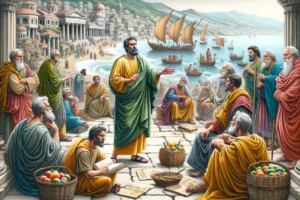
The Shipwreck of Paul
The shipwreck of Paul, as recorded in Acts 27:13-44, is a dramatic and pivotal event in the New Testament, illustrating Paul’s journey to Rome and his unshakable faith in God amidst life-threatening circumstances.
Quick Facts:
- Setting Out: The journey began poorly, with adverse winds making travel difficult, prompting changes in the planned route.
- Paul’s Warning: Paul, sensing danger, warned the ship’s crew of impending disaster if they continued, but his warnings were ignored.
- The Storm: A violent storm, called a “northeaster,” struck, driving the ship for days, with the crew eventually losing all hope of survival.
- Paul’s Assurance: An angel of God appeared to Paul, reassuring him that all aboard would be spared, though the ship would be lost.
- Shipwreck: Following Paul’s guidance, the ship ran aground near Malta. The ship broke apart, but all aboard reached land safely, as promised.
- Divine Purpose: This event not only demonstrated God’s protection over Paul but also facilitated the spread of the Gospel in Malta.
1. Historical and Geographical Context
Acts 27 offers a detailed narrative that not only emphasizes the historical accuracy of Luke as a chronicler but also showcases the perilous nature of ancient maritime travel. The journey began from Caesarea, headed to Rome, where Paul was to stand trial before Caesar. This passage is rich with specific navigational details, illustrating the route and the challenges faced, particularly around the island of Crete and leading to Malta.
2. Theological Insights
- Providence and Purpose: Throughout the narrative, the theme of divine providence is prominent. Despite human error and natural disaster, God’s purpose to bring Paul to Rome is unthwarted. This aligns with the overarching theme of Acts, where the spread of the Gospel is continually advanced through divine intervention despite opposition.
- Faith Amidst Fear: Paul stands out as a figure of calm and faith in the midst of chaos. His interactions reveal his deep trust in God’s promises, serving as a spiritual leader to the 276 souls aboard. His assurance of safety, based on the angelic visitation, highlights his prophetic role and the miraculous nature of their survival.
3. Literary Elements
Luke’s use of detailed narrative style in this passage serves multiple purposes. It adds credibility to the account, provides a vivid portrayal of the drama, and sets a contrast between the despair of the sailors and the steadfastness of Paul. This dichotomy enhances the impact of Paul’s faith and leadership.
4. Cultural and Societal Impact
The shipwreck led to Paul’s unexpected ministry in Malta, where he performed miracles and further spread the Christian message. This incident illustrates how seemingly adverse circumstances were used for the expansion of early Christianity. It also reflects the early Christian view that believers, while not spared from the world’s dangers, are sustained through divine grace.
5. Modern-Day Implications
For contemporary believers, Paul’s shipwreck serves as a metaphor for resilience and faithfulness in trials. It reassures that God’s plans are sovereign even in crises, and His purposes can be fulfilled through our trials. The narrative encourages a trust in divine oversight that transcends immediate circumstances.
6. Conclusion
The account of Paul’s shipwreck is a complex tapestry of adventure, faith, and divine intervention, rich in historical detail and theological depth. It is a profound example of how faith can provide stability and hope in the most turbulent times, and how God’s purposes are worked out through even the most challenging circumstances.



